The Plant Growth Regulator 14-OH BR Can Minimize the Application Content of CPPU in Kiwifruit (Actinidia chinensis) ‘Donghong’ and Increase Postharvest Time without Sacrificing the Yield
Abstract
:1. Introduction
2. Materials and Methods
2.1. Plant Materials
2.2. Experimental PGRs
2.3. Experimental Treatments
2.4. Evaluation of Fruit Quality
2.5. Fruit Postharvest Storage Quality
2.6. Transcriptome Profiling
2.6.1. RNA Extraction and RNA-Seq
2.6.2. Sequence Data Processing
2.7. Statistical Analysis
3. Results
3.1. The Effect of Different Treatments on Fruit Development of A. chinensis ‘Donghong’
3.2. Evaluation of Fruit Postharvest Quality of Different Treatments
3.3. Comprehensive Evaluation of Different PGRs on Regulation of Fruits Characteristics during Substitution of CPPU in Kiwifruit ‘Donghong’
3.4. Transcriptional Enrichment Analysis of 14-OH BR Regulation of Kiwifruit Development
3.5. Candidate Genes Related to Phytohormone Signaling Transduction Involved in 14-OH BR-Regulated Kiwifruit Development
4. Discussion
5. Conclusions
Supplementary Materials
Author Contributions
Funding
Institutional Review Board Statement
Informed Consent Statement
Data Availability Statement
Acknowledgments
Conflicts of Interest
References
- Wu, B.-L. Some new kiwifruit cultivars. J. Fruit Sci. 1992, 9, 56–58. [Google Scholar]
- Balestra, G.M.; Mazzaglia, A.; Quattrucci, A.; Renzi, M.; Rossetti, A. Occurrence of Pseudomonas syringae pv. Actinidiae in Jin Tao kiwi plants in Italy. Phytopathol. Mediterr. 2009, 48, 299–301. [Google Scholar]
- Zhong, C.H.; Han, F.; Li, D.W.; Liu, X.L.; Zhang, Q.; Jiang, Z.W.; Huang, H.W. Breeding of red-fleshed kiwifruit cultivar ‘Donghong’. J. Fruit Sci. 2016, 33, 1596–1599. [Google Scholar] [CrossRef]
- Nie, X.-R.; Li, H.-Y.; Wei, S.-Y.; Han, Q.-H.; Zhao, L.; Zhang, Q.; Li, S.-Q.; Qin, W.; Wu, D.-T. Changes of phenolic compounds, antioxidant capacities, and inhibitory effects on digestive enzymes of kiwifruits (Actinidia chinensis) during maturation. J. Food Meas. 2020, 14, 1765–1774. [Google Scholar] [CrossRef]
- Huang, W.; Wang, Z.; Zhang, Q.; Feng, S.; Burdon, J.; Zhong, C.J.H. Maturity, Ripening and Quality of ‘Donghong’ Kiwifruit Evaluated by the Kiwi-Meter™. Horticulturae 2022, 8, 852. [Google Scholar] [CrossRef]
- Blank, R.H.; Richardson, A.C.; Oshima, K.; Hampton, R.E.; Olson, M.H.; Dawson, T.E. Effect of a forchlorfenuron dip on kiwifruit fruit size. N. Z. J. Crop Hortic. Sci. 1992, 20, 73–78. [Google Scholar] [CrossRef]
- Wu, L.; Lan, J.; Xiang, X.; Xiang, H.; Jin, Z.; Khan, S.; Liu, Y. Transcriptome sequencing and endogenous phytohormone analysis reveal new insights in CPPU controlling fruit development in kiwifruit (Actinidia chinensis). PLoS ONE 2020, 15, e0240355. [Google Scholar] [CrossRef]
- Kim, J.G.; Takami, Y.; Mizugami, T.; Beppu, K.; Fukuda, T.; Kataoka, I. CPPU application on size and quality of hardy kiwifruit. Sci. Hortic. 2006, 110, 219–222. [Google Scholar] [CrossRef]
- Zabadal, T.J.; Bukovac, M.J. Effect of CPPU on Fruit Development of Selected Seedless and Seeded Grape Cultivars. HortScience 2006, 41, 154–157. [Google Scholar] [CrossRef]
- Stern, R.A.; Ben-Arie, R.; Neria, O.; Flaishman, M. CPPU and BA increase fruit size of ‘Royal Gala’ (Malus domestica) apple in a warm climate. J. Hortic. Sci. Biotechnol. 2003, 78, 297–302. [Google Scholar] [CrossRef]
- Ying, H.; Shi, J.; Zhang, S.; Pingcuo, G.; Wang, S.; Zhao, F.; Cui, Y.; Zeng, X. Transcriptomic and metabolomic profiling provide novel insights into fruit development and flesh coloration in Prunus mira Koehne, a special wild peach species. BMC Plant Biol. 2019, 19, 463. [Google Scholar] [CrossRef] [PubMed]
- Janowska, B.; Andrzejak, R. Cytokinins and Gibberellins Stimulate the Flowering and Post-Harvest Longevity of Flowers and Leaves of Calla Lilies (Zantedeschia Spreng.) with Colourful Inflorescence Spathes. Agronomy 2022, 12, 1859. [Google Scholar] [CrossRef]
- Janowska, B. Effect of growth regulators on flower and leaf yield of the calla lily (Zantedeschia Spreng.). Hortic. Sci. 2013, 40, 78–82. [Google Scholar] [CrossRef] [Green Version]
- Kozłowska, M.; Rybus-Zając, M.; Stachowiak, J.; Janowska, B. Changes in carbohydrate contents of Zantedeschia leaves under gibberellin-stimulated flowering. Acta Physiol. Plant. 2007, 29, 27–32. [Google Scholar] [CrossRef]
- Janowska, B.; Stanecki, M. Effect of rhizome soaking in a mixture of BA and GA3 on the earliness of flowering and quality of the yield of flowers and leaves in the calla lily (Zantedeschia Spreng.). Acta Sci. Polonorum. Hortorum Cultus 2013, 12, 3–12. [Google Scholar]
- Andrzejak, R.; Janowska, B. Yield and Quality of Inflorescences in the Zantedeschia albomaculata (Hook.) Baill. ‘Albomaculata’ after the Treatment with AMF and GA3. Agronomy 2021, 11, 644. [Google Scholar] [CrossRef]
- Janowska, B.; Andrzejak, R.; Kosiada, T.; Kwiatkowska, M.; Smolinska, D. The flowering and nutritional status of Gladiolus hybridus cv. Black Velvet following a cytokinin treatment. J. Elem. 2018, 23, 1119–1128. [Google Scholar] [CrossRef]
- Janowska, B.; Andrzejak, R.; Kosiada, T.; Kwiatkowska, M.; Smolińska, D.J.H.S. Flowering and nutritional status of Gladiolus hybridus L. ‘Black Velvet’ following gibberellin treatment. Hortic. Sci. 2018, 45, 205–210. [Google Scholar] [CrossRef] [Green Version]
- Janowska, B.; Andrzejak, R.; Szwajkowska-Michałek, L.; Stuper-Szablewska, K.J.A. The Content of Biologically Active Substances in Crocosmia× crocosmiiflora ‘Lucifer’ Tubers after Treatment with GA3. Agronomy 2021, 11, 553. [Google Scholar] [CrossRef]
- Andrzejak, R.; Janowska, B.; Reńska, B.; Kosiada, T. Effect of Trichoderma spp. and fertilization on the flowering of Begonia× tuberhybrida Voss. ‘Picotee Sunburst’. Agronomy 2021, 11, 1278. [Google Scholar] [CrossRef]
- Andrzejak, R.; Janowska, B. Flowering, Nutritional Status, and Content of Chloroplast Pigments in Leaves of Gladiolus hybridus L. ‘Advances Red’ after Application of Trichoderma spp. Sustainability 2022, 14, 4576. [Google Scholar] [CrossRef]
- Dong, J.; Guo, W.; Zhao, F.; Liu, D. Discrimination of “Hayward” Kiwifruits Treated with Forchlorfenuron at Different Concentrations Using Hyperspectral Imaging Technology. Food Anal. Methods 2017, 10, 477–486. [Google Scholar] [CrossRef]
- Bu, Q.; Wang, X.; Xie, H.; Zhong, K.; Wu, Y.; Zhang, J.; Wang, Z.; Gao, H.; Huang, Y. 180 Day Repeated-Dose Toxicity Study on Forchlorfenuron in Sprague–Dawley Rats and Its Effects on the Production of Steroid Hormones. J. Agric. Food Chem. 2019, 67, 10207–10213. [Google Scholar] [CrossRef] [PubMed]
- Gong, G.; Kam, H.; Tse, Y.; Lee, S.M. Cardiotoxicity of forchlorfenuron (CPPU) in zebrafish (Danio rerio) and H9c2 cardiomyocytes. Chemosphere 2019, 235, 153–162. [Google Scholar] [CrossRef]
- He, Q. Preparation Method, Agricultural Composition and Applications of Natural Brassinolide Analogs. U.S. Patent 9,326,506, 3 May 2016. [Google Scholar]
- Cebalo, T.; Letham, D.S. Synthesis of Zeatin, a Factor inducing Cell Division. Nature 1967, 213, 86. [Google Scholar] [CrossRef]
- Ito, A.; Sakamoto, D.; Itai, A.; Nishijima, T.; Oyama-Okubo, N.; Nakamura, Y.; Moriguchi, T.; Nakajima, I. Effects of GA3+4 and GA4+7 Application Either Alone or Combined with Prohexadione-Ca on Fruit Development of Japanese Pear ’Kosu’. Hortic. J. 2016, 85, 201–208. [Google Scholar] [CrossRef] [Green Version]
- Kvesitadze, G.I.; Kalandiya, A.G.; Papunidze, S.G.; Vanidze, M.R. Identification and Quantification of Ascorbic Acid in Kiwi Fruit by High-Performance Liquid Chromatography. Appl. Biochem. Microbiol. 2001, 37, 215–218. [Google Scholar] [CrossRef]
- GB/T 12456-2008; Determination of Total Acid in Food. National Standards Organization: Beijing, China, 2008.
- GB 5009.268-2016; National Food Safety Standard—Determination of Multi-elements in Foods. National Standards Organization: Beijing, China, 2016.
- Jiang, Y. Plant growth regulator 14-hydroxylated brassinosteroid. Pestic. Sci. Admin. 2018, 39, 67. [Google Scholar]
- WANG, Z. Brassinosteroid regulated kinases (BRKs) that mediate brassinosteroid signal transduction and uses thereof. U.S. Patent 8,541,649, 24 September 2013. [Google Scholar]
- Végvári, G.; Vidéki, E. Plant hormones, plant growth regulators. Orvosi Hetil. 2014, 155, 1011–1018. [Google Scholar] [CrossRef]
- Zhang, Z.; Gao, Z.; Wang, Y.; Yuan, Y.; Dong, J.; Yue, T. Transformation products elucidation of forchlorfenuron in postharvest kiwifruit by time-of-flight mass spectrometry. PLoS ONE 2017, 12, e0184021. [Google Scholar] [CrossRef] [Green Version]
- Olszewski, N.; Sun, T.-P.; Gubler, F. Gibberellin signaling: Biosynthesis, catabolism, and response pathways. Plant Cell 2002, 14, S61–S80. [Google Scholar] [CrossRef] [PubMed] [Green Version]
- Serrani, J.C.; Sanjuán, R.; Ruiz-Rivero, O.; Fos, M.; García-Martínez, J.L. Gibberellin regulation of fruit set and growth in tomato. Plant Physiol. 2007, 145, 246–257. [Google Scholar] [CrossRef] [Green Version]
- Kappel, F.; MacDonald, R.A. Gibberellic acid increases fruit firmness, fruit size, and delays maturity of ‘Sweetheart’ sweet cherry. J. Am. Pomol. Soc. 2002, 56, 219. [Google Scholar]
- Mok, D.W.; Mok, M.C. Cytokininschemistry, Activity, and Function; CRC Press: Boca Raton, FL, USA, 1994. [Google Scholar]
- Schiller, L.G.; Magnitskiy, S. Effect of trans-zeatin riboside application on growth of banana (Musa AAA Simmonds) cv. Williams in the juvenile phase. Rev. Colomb. De Cienc. Hortícolas 2019, 13, 161–170. [Google Scholar] [CrossRef]
- Baghel, M.; Nagaraja, A.; Srivastav, M.; Meena, N.K.; Senthil Kumar, M.; Kumar, A.; Sharma, R.R. Pleiotropic influences of brassinosteroids on fruit crops: A review. Plant Growth Regul. 2019, 87, 375–388. [Google Scholar] [CrossRef]
- Vardhini, B.V.; Rao, S.R. Acceleration of ripening of tomato pericarp discs by brassinosteroids. Phytochemistry 2002, 61, 843–847. [Google Scholar] [CrossRef]
- Symons, G.M.; Davies, C.; Shavrukov, Y.; Dry, I.B.; Reid, J.B.; Thomas, M.R. Grapes on steroids. Brassinosteroids are involved in grape berry ripening. Plant Physiol. 2006, 140, 150–158. [Google Scholar] [CrossRef] [Green Version]
- Fu, F.Q.; Mao, W.H.; Shi, K.; Zhou, Y.H.; Asami, T.; Yu, J.Q. A role of brassinosteroids in early fruit development in cucumber. J. Exp. Bot. 2008, 59, 2299–2308. [Google Scholar] [CrossRef]
- Pabón-Mora, N.; Wong, G.K.-S.; Ambrose, B.A. Evolution of fruit development genes in flowering plants. Front. Plant Sci. 2014, 5, 300. [Google Scholar] [CrossRef] [Green Version]
- Renaudin, J.-P.; Deluche, C.; Cheniclet, C.; Chevalier, C.; Frangne, N. Cell layer-specific patterns of cell division and cell expansion during fruit set and fruit growth in tomato pericarp. J. Exp. Bot. 2017, 68, 1613–1623. [Google Scholar] [CrossRef] [Green Version]
- Li, W.; Liu, Y.; Zeng, S.; Xiao, G.; Wang, G.; Wang, Y.; Peng, M.; Huang, H. Gene Expression Profiling of Development and Anthocyanin Accumulation in Kiwifruit (Actinidia chinensis) Based on Transcriptome Sequencing. PLoS ONE 2015, 10, e01364399. [Google Scholar] [CrossRef] [Green Version]
- Nitsch, L.; Kohlen, W.; Oplaat, C.; Charnikhova, T.; Cristescu, S.; Michieli, P.; Wolters-Arts, M.; Bouwmeester, H.; Mariani, C.; Vriezen, W.H.; et al. ABA-deficiency results in reduced plant and fruit size in tomato. J. Plant Physiol. 2012, 169, 878–883. [Google Scholar] [CrossRef]
- Gansser, D.; Latza, S.; Berger, R.G. Methyl jasmonates in developing strawberry fruit (Fragaria ananassa Duch. Cv. Kent). J. Agric. Food Chem. 1997, 45, 2477–2480. [Google Scholar] [CrossRef]
- Fei, L.; Yuan, X.; Chen, C.; Wan, C.; Fu, Y.; Chen, J.; Gan, Z.J.A. Exogenous application of sucrose promotes postharvest ripening of kiwifruit. Agronomy 2020, 10, 245. [Google Scholar] [CrossRef]
- Bangerth, F.K. Can regulatory mechanism in fruit growth and development be elucidated through the study of endogenous hormone concentrations? In Proceedings of the VIII International Symposium on Plant Bioregulation in Fruit Production 463, Valencia, Spain, 1–4 April 1997; pp. 77–88. [Google Scholar]
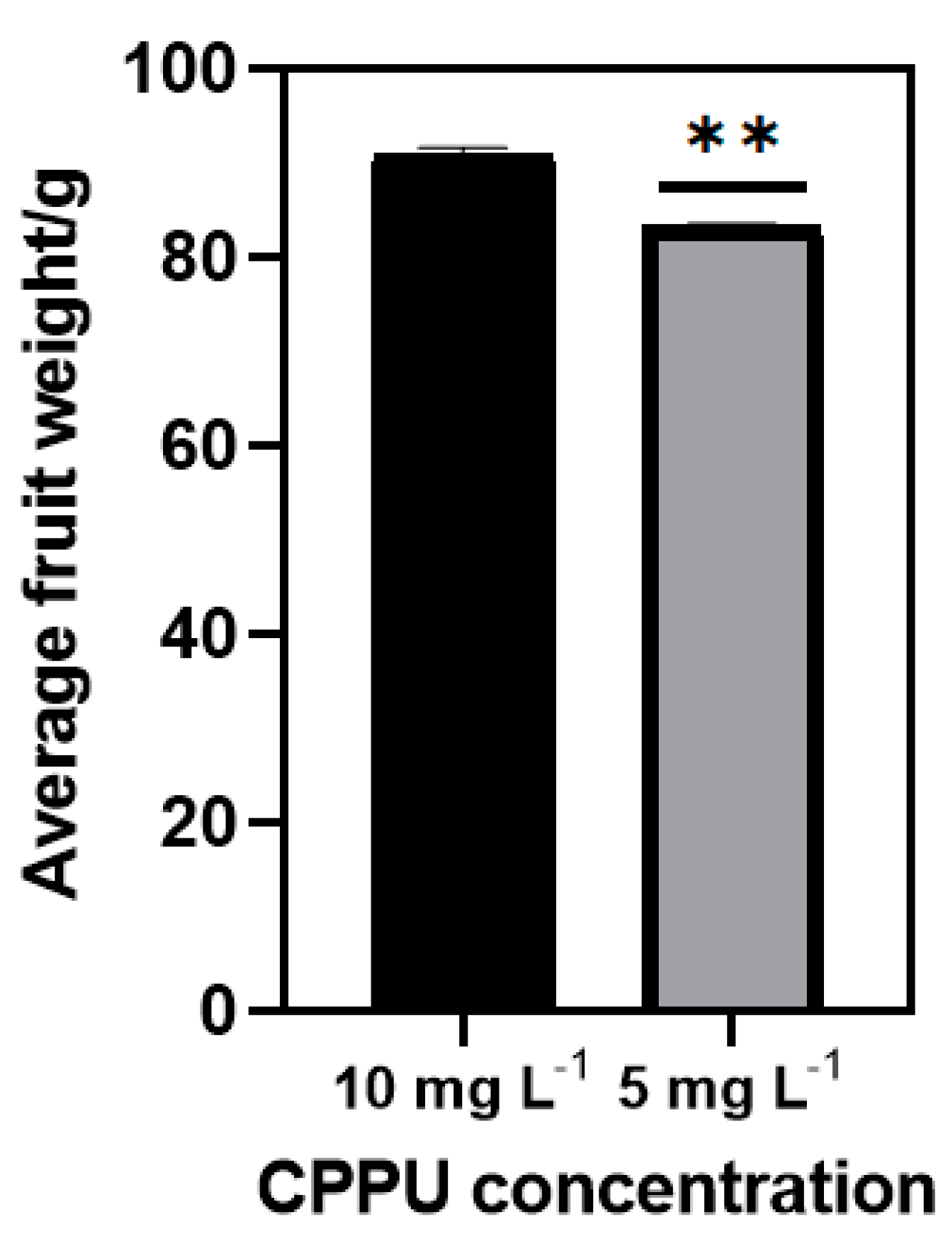
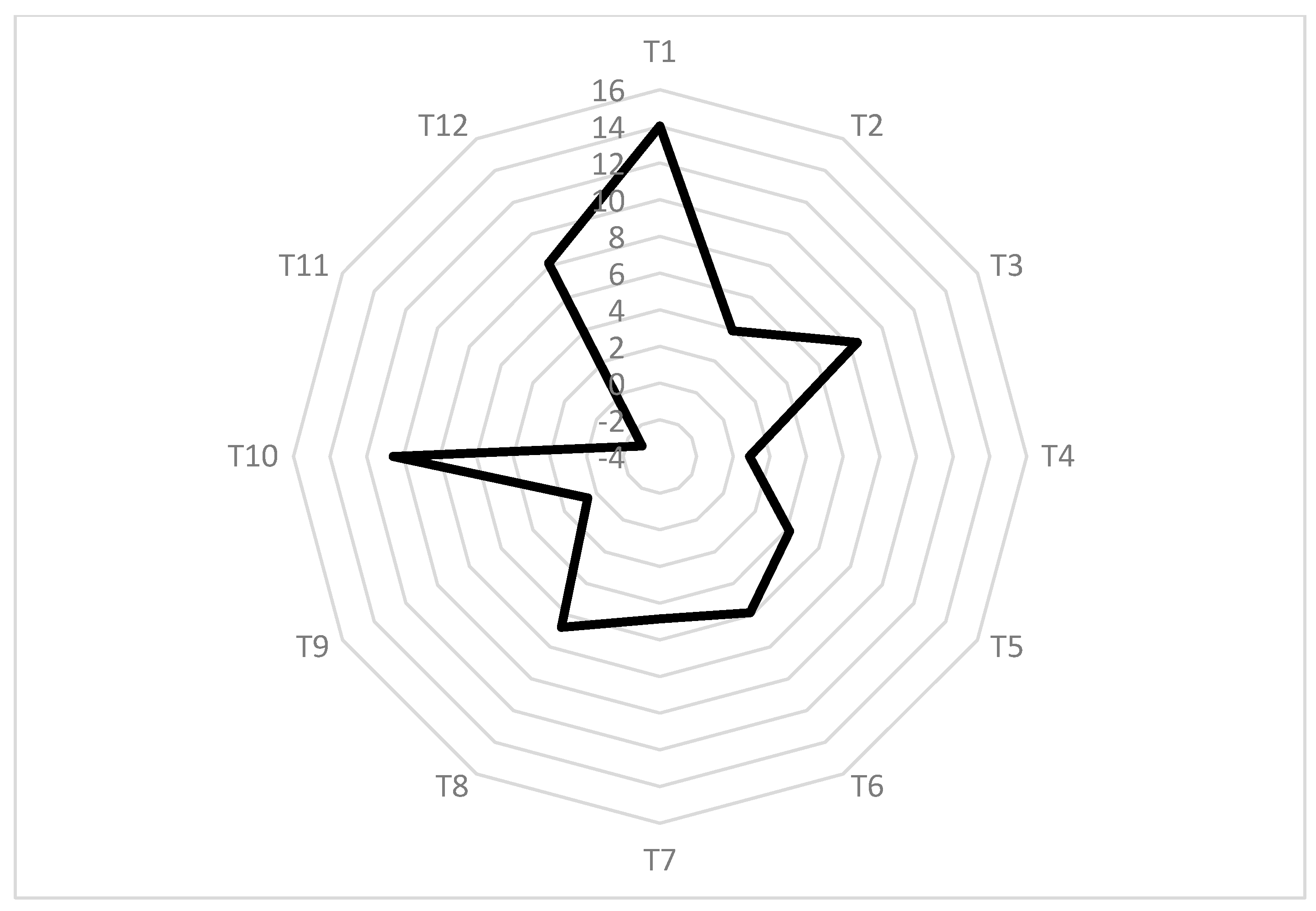
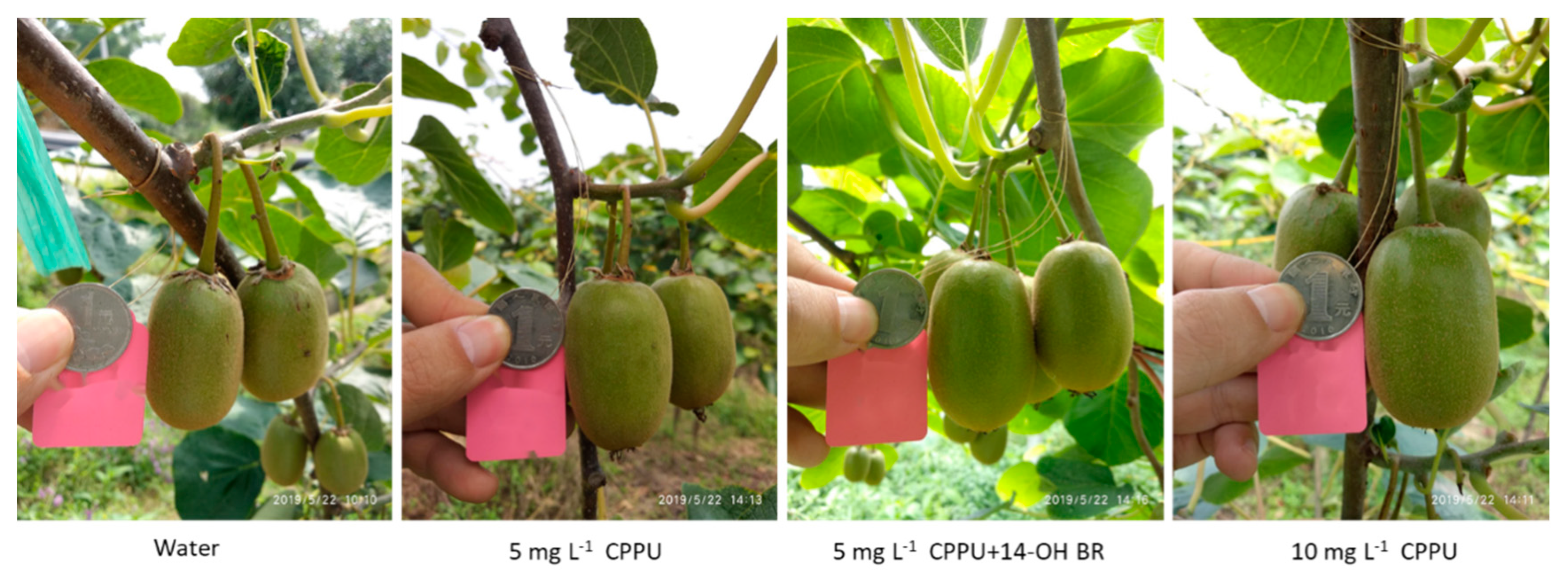
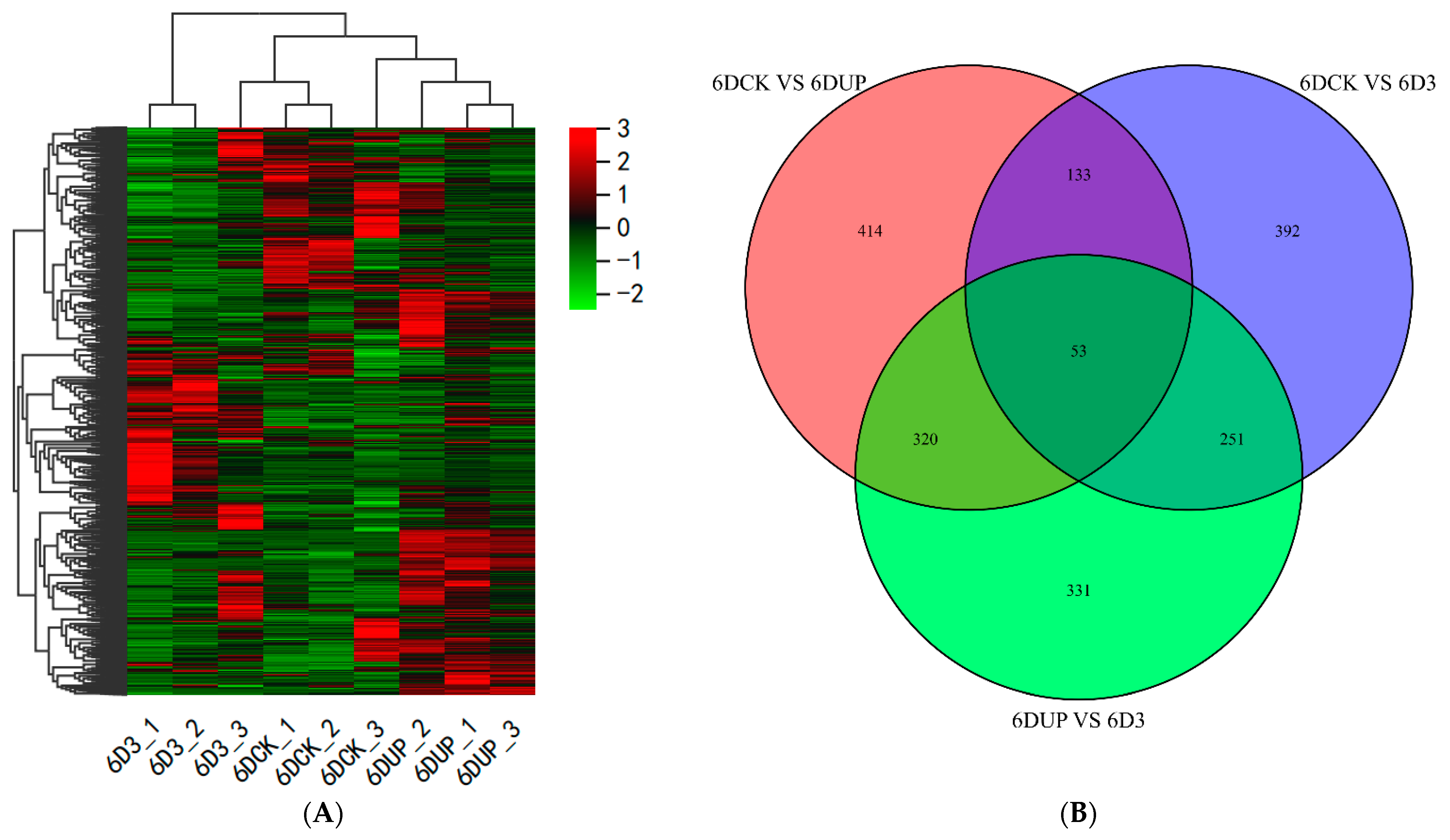

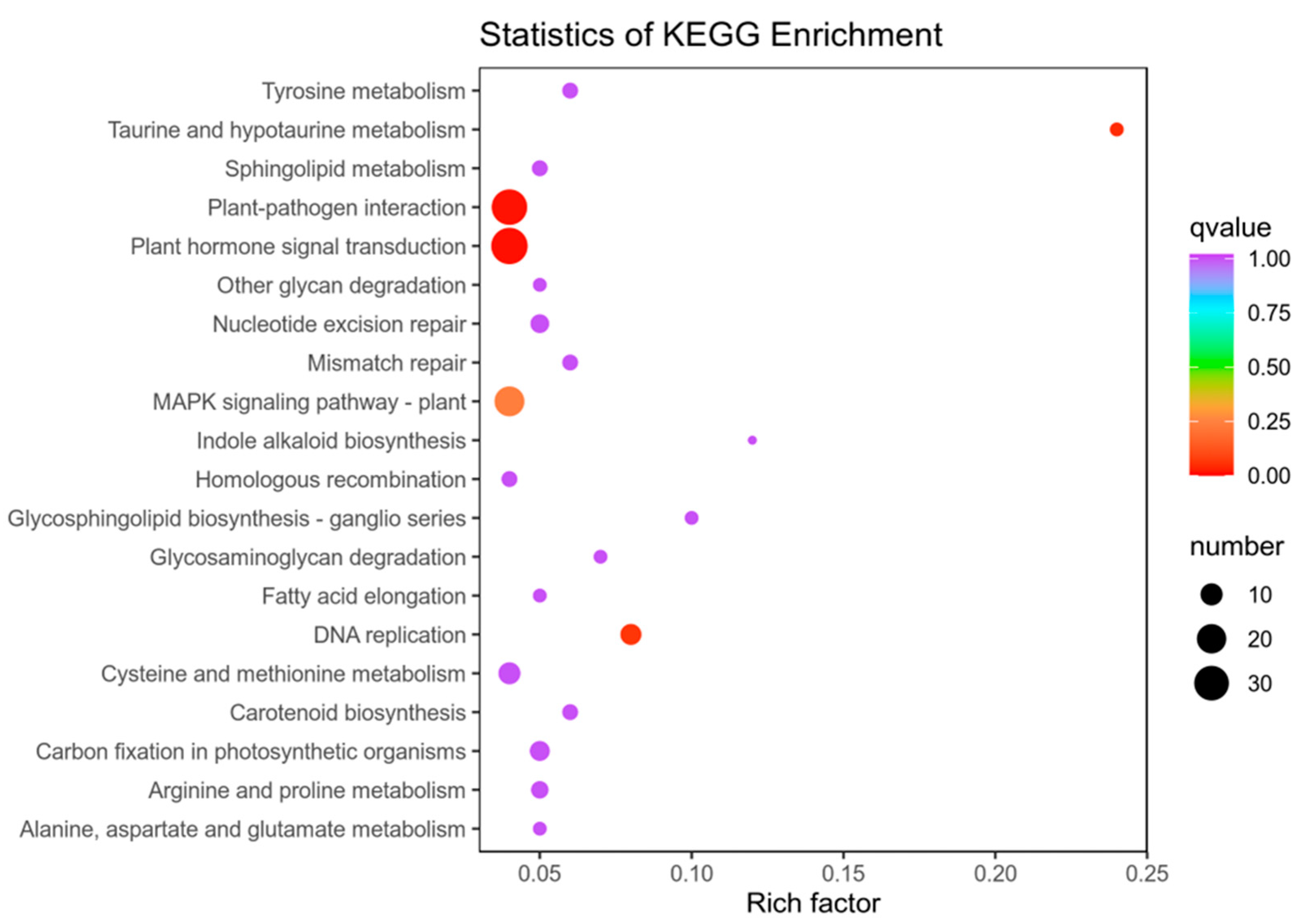
| Treatment | Fruit Weight (g) | Shape index | Hardness (N/cm) | TSS (%) | Titratable Acids | TSS/TA Ratio | Vitamine C (mg/100 g) |
|---|---|---|---|---|---|---|---|
| Control | 90.27 ± 4.62 a | 1.22 ± 0.11 a | 36.27 ± 4.56 b | 9.4 ± 0.28 a | 1.1 ± 0.02 a | 8.54 ± 0.03 a | 87.36 ± 2.34 a |
| T1 | 96.82 ± 3.28 a | 1.38 ± 0.12 a | 42.73 ± 3.04 a | 9.1 ± 0.35 a | 1.06 ± 0.03 a | 8.49 ± 0.58 a | 84.05 ± 4.82 a |
| T2 | 92.17 ± 18.36 a | 1.2 ± 0.02 a | 47.04 ± 2.89 a | 8.5 ± 1.55 a | 1.11 ± 0.07 a | 7.65 ± 1.76 a | 77.23 ± 4.15 b |
| T3 | 66.21 ± 10.55 b | 1.22 ± 0.11 a | 51.13 ± 7.13 a | 6.3 ± 1.97 b | 1.22 ± 0.01 a | 5.16 ± 1.71 b | 71.36 ± 3.18 b |
| T4 | 81.13 ± 11.53 b | 1.21 ± 0.01 a | 41.04 ± 1.47 a | 9.1 ± 0.71 a | 1.2 ± 0.07 a | 7.58 ± 0.21 a | 75.86 ± 7.08 b |
| T5 | 97.44 ± 10.49 a | 1.23 ± 0.01 a | 43.12 ± 0.26 a | 8.1 ± 0.56 a | 1.1 ± 0.07 a | 7.27 ± 0.1 a | 85.88 ± 6.18 a |
| T6 | 98.14 ± 4.7 a | 1.23 ± 0.03 a | 42.74 ± 1.14 a | 8.9 ± 0.42 a | 1.2 ± 0.11 a | 7.41 ± 0.39 a | 77.14 ± 3.52 b |
| T7 | 91.48 ± 1.61 a | 1.27 ± 0.04 a | 44.36 ± 2.22 a | 8.3 ± 0.35 a | 1.04 ± 0.06 a | 7.98 ± 0.13 a | 72.15 ± 7.51 b |
| T8 | 93.77 ± 8.85 a | 1.21 ± 0.01 a | 41.22 ± 2.01 a | 8.8 ± 1.34 a | 1.13 ± 0.02 a | 7.78 ± 1.32 a | 82.76 ± 0.37 a |
| T9 | 92.56 ± 5.81 a | 1.22 ± 0.01 a | 44.07 ± 1.02 a | 6.9 ± 0.63 b | 1.16 ± 0.11 a | 5.44 ± 0.02 b | 83.29 ± 6.21 a |
| T10 | 84.35 ± 3.35 a | 1.21 ± 0.01 a | 42.62 ± 1.53 a | 7.8 ± 0.42 b | 1.32 ± 0.05 a | 5.96 ± 0.61 b | 92.08 ± 5.09 a |
| T11 | 89.09 ± 5.3 a | 1.19 ± 0.01 a | 40.45 ± 0.96 a | 8.4 ± 0.56 a | 1.24 ± 0.03 a | 6.77 ± 0.25 b | 84.87 ± 6.01 a |
| T12 | 89.51 ± 6.24 a | 1.18 ± 0.02 a | 39.09 ± 1.05 a | 9.2 ± 0.35 a | 1.29 ± 0.01 a | 7.13 ± 0.62 a | 93.38 ± 6.32 a |
| Treatment | Ca | Mg | B | Cu | Fe | Mn | Mo | Zn |
|---|---|---|---|---|---|---|---|---|
| mg/kg | ||||||||
| Control | 117.9 ± 13.69 b | 95.6 ± 11.11 b | 2.57 ± 0.11 a | 2.1 ± 0.49 a | 2.42 ± 1.4 b | 0.015 ± 0.002 b | 0.94 ± 0.1 a | 0.74 ± 0.07 b |
| T1 | 250.4 ± 15.48 a | 139.6 ± 13.09 a | 2.41 ± 0.24 a | 1.3 ± 0.15 b | 0.44 ± 1.27 c | 0.011 ± 0.002 b | 1.09 ± 0.06 a | 0.84 ± 0.04 b |
| T2 | 129.5 ± 13.43 b | 92.8 ± 11.31 b | 2.07 ± 0.27 a | 1.52 ± 0.02 b | 2.24 ± 0.68 b | 0.015 ± 0.002 b | 1.02 ± 0.24 a | 0.77 ± 0.24 b |
| T3 | 110.5 ± 8.48 b | 108.8 ± 3.46 b | 2.46 ± 0.02 a | 1.48 ± 0.13 b | 3.21 ± 0.81 ab | 0.019 ± 0.004 b | 1.35 ± 0.19 a | 1.12 ± 0.36 b |
| T4 | 122.5 ± 13.5 b | 103.9 ± 5.02 b | 2.5 ± 0.01 a | 1.29 ± 0.02 a | 2.06 ± 0.05 b | 0.013 ± 0.003 b | 1.08 ± 0.04 a | 0.61 ± 0.19 b |
| T5 | 141.6 ± 2.26 b | 111 ± 8.7 b | 2.51 ± 0.26 a | 1.33 ± 0.14 b | 2.14 ± 0.7 b | 0.008 ± 0.002 b | 1.02 ± 0.06 a | 0.88 ± 0.19 b |
| T6 | 138.4 ± 13.15 b | 110 ± 8.06 b | 2.13 ± 0.12 a | 1.12 ± 0.02 b | 3.13 ± 0.86 ab | 0.008 ± 0.003 b | 0.93 ± 0.09 a | 0.6 ± 0.11 b |
| T7 | 119.8 ± 11.59 b | 111.5 ± 6.97 b | 1.96 ± 0.32 b | 1.15 ± 0.28 b | 1.91 ± 0.62 b | 0.013 ± 0.001 b | 1.07 ± 0.01 a | 0.75 ± 0.02 b |
| T8 | 136.2 ± 16.16 b | 114.3 ± 14.01 b | 2.42 ± 0.12 a | 1.56 ± 0.16 b | 2.79 ± 0.03 b | 0.012 ± 0.002 b | 1.07 ± 0.03 a | 0.79 ± 0.02 b |
| T9 | 99.2 ± 2.89 b | 94.5 ± 4.84 b | 2.25 ± 0.05 a | 1.32 ± 0.16 b | 2.84 ± 0.86 b | 0.012 ± 0.001 b | 1.12 ± 0.11 a | 0.82 ± 0.01 b |
| T10 | 103.3 ± 12.09 b | 95.7 ± 12.02 b | 2.17 ± 0.06 a | 1.56 ± 0.31 b | 4.06 ± 1.19 a | 0.014 ± 0.002 b | 1.28 ± 0.11 a | 0.84 ± 0.16 b |
| T11 | 120.4 ± 4.38 b | 112.7 ± 4.45 b | 2.08 ± 0.04 a | 1.12 ± 0.58 b | 2.37 ± 0.12 b | 0.011 ± 0.014 b | 1.12 ± 0.14 a | 0.61 ± 0.44 b |
| T12 | 126.6 ± 9.28 b | 119 ± 10.12 b | 2.14 ± 0.03 a | 1.95 ± 0.61 b | 2.55 ± 0.49 b | 0.031 ± 0.01 a | 1.33 ± 0.12 a | 1.24 ± 0.21 a |
| Treatment | Hardness (N/cm) | TSS (%) | Dry Matter (%) | ||
|---|---|---|---|---|---|
| Day 3 | Day 7 | Day 12 | |||
| Control | 12.36 ± 0.68 b | 6.04 ± 0.54 b | 4.37 ± 0.72 b | 12.76 ± 0.56 a | 13.97 ± 1.18 a |
| T1 | 13.85 ± 0.23 b | 7.52 ± 0.43 b | 5.27 ± 0.56 b | 13.56 ± 0.26 a | 16.81 ± 0.24 a |
| T2 | 15.69 ± 0.12 b | 8.46 ± 0.28 b | 6.58 ± 0.04 b | 13.56 ± 1.78 a | 14.41 ± 0.47 a |
| T3 | 17.08 ± 0.90 a | 11.32 ± 1.10 a | 8.92 ± 1.3 a | 11.03 ± 0.91 a | 14.64 ± 0.36 a |
| T4 | 12.34 ± 1.10 b | 6.89 ± 0.13 b | 4.88 ± 0.09 b | 12.33 ± 0.22 a | 15.27 ± 0.96 a |
| T5 | 13.87 ± 1.02 b | 7.24 ± 0.12 b | 5.35 ± 0.09 b | 12.65 ± 0.14 a | 15.04 ± 0.46 a |
| T6 | 15.98 ± 1.12 b | 9.35 ± 1.09 b | 6.41 ± 1.08 b | 12.45 ± 0.7 a | 15.89 ± 1.65 a |
| T7 | 17.55 ± 0.77 a | 11.23 ± 0.87 a | 8.91 ± 0.37 a | 13.45 ± 0.39 a | 15.41 ± 1.03 a |
| T8 | 14.23 ± 0.94 b | 7.68 ± 0.78 b | 5.29 ± 0.34 b | 14.01 ± 0.62 a | 14.99 ± 0.45 a |
| T9 | 15.02 ± 1.20 b | 7.02 ± 0.80 b | 4.69 ± 1.80 b | 13.13 ± 0.33 a | 15.01 ± 0.09 a |
| T10 | 15.59 ± 1.13 b | 8.69 ± 0.69 b | 6.35 ± 0.93 b | 12.66 ± 0.70 a | 16.66 ± 0.08 a |
| T11 | 11.45 ± 0.85 b | 5.76 ± 0.12 b | 3.56 ± 0.65 b | 13.65 ± 0.19 a | 13.84 ± 0.39 a |
| T12 | 12.32 ± 1.21 b | 5.88 ± 1.02 b | 3.47 ± 1.40 b | 13.37 ± 0.41 a | 14.61 ± 1.18 a |
| ID | Functional Description | log2FoldChange (6D3 vs. 6DUP) | p-Value | Regulated |
|---|---|---|---|---|
| Ethylene signaling | ||||
| gene-CEY00_Acc29732 | ethylene receptor | 1.139 | 0.000275 | up |
| Gibberellin signaling | ||||
| gene-CEY00_Acc00196 | transcription factor PIF3 | 1.857 | 1.86 × 10−5 | up |
| gene-CEY00_Acc31645 | gibberellin receptor GID1 | 3.242 | 1.72 × 10−8 | up |
| gene-CEY00_Acc00595 | DELLA protein SLR1 | −2.127 | 3.50 × 10−5 | down |
| gene-CEY00_Acc16443 | DELLA protein GA | −1.072 | 2.18 × 10−9 | down |
| gene-CEY00_Acc31074 | DELLA protein | −1.128 | 9.64 × 10−8 | down |
| Abscisic acid signaling | ||||
| gene-CEY00_Acc01626 | protein phosphatase 2C 37-like | −2.358 | 4.32 × 10−13 | down |
| gene-CEY00_Acc25841 | protein phosphatase 2C | −2.137 | 1.51 × 10−6 | down |
| gene-CEY00_Acc03739 | protein phosphatase 2C 37-lik | −1.143 | 2.16 × 10−5 | down |
| jasmonate acid biosynthesis and signaling | ||||
| gene-CEY00_Acc02848 | coronatine-insensitive protein 1 | 1.27 | 0.001792 | up |
| gene-CEY00_Acc19795 | JAR1-like | 1.857 | 0.000702 | up |
| gene-CEY00_Acc29006 | transcription factor MYC2 | −2.414 | 2.1 0× 10−20 | down |
| gene-CEY00_Acc28151 | transcription factor MYC2 | −2.484 | 9.81 × 10−21 | down |
| gene-CEY00_Acc17977 | transcription factor MYC2-like | 1.925 | 0.001716 | up |
| gene-CEY00_Acc12940 | JAZ1 | −1.778 | 1.67 × 10−5 | down |
| Auxin signaling | ||||
| gene-CEY00_Acc07415 | auxin synthetase GH3 | −5.077 | 2.61 × 10−77 | down |
| gene-CEY00_Acc19916 | auxin-responsive protein SAUR36 | −6.22 | 3.52 × 10−11 | down |
| gene-CEY00_Acc23578 | auxin-induced protein 6B-like | 1.34 | 0.000355 | up |
| gene-CEY00_Acc32215 | auxin response factor | 1.666 | 0.001074 | up |
| gene-CEY00_Acc30497 | AUXIN SIGNALING F-BOX 2-like | 1.009 | 5.28 × 10−5 | up |
| gene-CEY00_Acc25587 | auxin-responsive protein IAA4-like | −1.651 | 2.52 × 10−10 | down |
| gene-CEY00_Acc28907 | auxin-responsive protein SAUR36 | −7.345 | 1.62 × 10−7 | down |
| gene-CEY00_Acc25588 | auxin-responsive protein IAA4-like | −1.58 | 2.73 × 10−5 | down |
| gene-CEY00_Acc16761 | auxin-responsive protein SAUR36-lik | −6.026 | 3.32 × 10−10 | down |
| gene-CEY00_Acc08534 | auxin response factor 19 | 1.021 | 1.43 × 10−6 | up |
| gene-CEY00_Acc09025 | auxin-responsive protein SAUR24 | −1.758 | 0.001619 | down |
| gene-CEY00_Acc19500 | auxin-induced protein 22D-like | -2.445 | 4.72 × 10−30 | down |
| gene-CEY00_Acc13744 | auxin early response protein GH3.5 | −6.588 | 4.41 × 10−9 | down |
| gene-CEY00_Acc10765 | auxin-responsive protein ARG7 | −1.323 | 0.000405 | down |
| Brassinosteriod signaling | ||||
| gene-CEY00_Acc29651 | receptor BRI1 | 1.229 | 3.24 × 10−5 | up |
| gene-CEY00_Acc12003 | transcription factor BES1/BZR1 | 1.603 | 0.000802 | up |
| gene-CEY00_Acc12063 | cyclin D3-1 | −1.131 | 0.000403 | down |
| gene-CEY00_Acc15686 | BR-signaling kinase | 1.5 | 0.000112 | up |
| Cytokinin signaling | ||||
| gene-CEY00_Acc29817 | ARR5-like isoform X1 | −1.931 | 0.002259 | down |
Publisher’s Note: MDPI stays neutral with regard to jurisdictional claims in published maps and institutional affiliations. |
© 2022 by the authors. Licensee MDPI, Basel, Switzerland. This article is an open access article distributed under the terms and conditions of the Creative Commons Attribution (CC BY) license (https://creativecommons.org/licenses/by/4.0/).
Share and Cite
Wang, Y.; Ma, B.; Li, Y.; Wu, D.; Du, B.; Wang, H.; Yang, P.; Ren, D.; Wang, X.; Huang, J. The Plant Growth Regulator 14-OH BR Can Minimize the Application Content of CPPU in Kiwifruit (Actinidia chinensis) ‘Donghong’ and Increase Postharvest Time without Sacrificing the Yield. Processes 2022, 10, 2345. https://doi.org/10.3390/pr10112345
Wang Y, Ma B, Li Y, Wu D, Du B, Wang H, Yang P, Ren D, Wang X, Huang J. The Plant Growth Regulator 14-OH BR Can Minimize the Application Content of CPPU in Kiwifruit (Actinidia chinensis) ‘Donghong’ and Increase Postharvest Time without Sacrificing the Yield. Processes. 2022; 10(11):2345. https://doi.org/10.3390/pr10112345
Chicago/Turabian StyleWang, Yanling, Baopeng Ma, Yuzhu Li, Dan Wu, Bo Du, Hang Wang, Peng Yang, Dan Ren, Xiaochun Wang, and Jin Huang. 2022. "The Plant Growth Regulator 14-OH BR Can Minimize the Application Content of CPPU in Kiwifruit (Actinidia chinensis) ‘Donghong’ and Increase Postharvest Time without Sacrificing the Yield" Processes 10, no. 11: 2345. https://doi.org/10.3390/pr10112345






